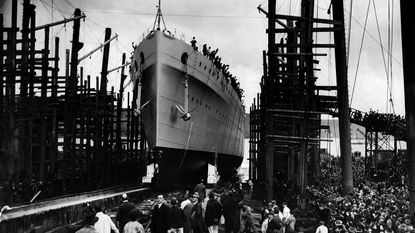Britain didn’t have a roaring ’20s, it had a roaring ’30s – here's why
Talk of a “roaring ’20s” for the UK following the pandemic is wide of the mark, writes author and analyst Bernard Connolly – would-be economic historians should look to the 1930s for a better comparison.

Widespread references to “the Roaring ’20s” in Britain following the end of an earlier pandemic indicate an almost total ignorance of economic history. A little – a very little – knowledge is indeed a dangerous thing.
There was strong growth in Britain in the second quarter of 1920 and, to a lesser extent, in the third quarter of that year. But an extremely sharp recession began in the autumn of 1920. Real (after-inflation) GDP in Britain is estimated to have fallen by 23% between the third quarter of 1920 and the second quarter of 1921, and it did not regain its previous high until the second quarter of 1924 – four years later. Even at the cyclical peak (for the level of GDP) in the first quarter of 1930, GDP was only 16% higher than in the second quarter of 1920, almost ten years earlier. The 1920s was a period of deflation, depression and persistent mass unemployment in Britain.
If any decade, or substantial part of a decade, in interwar (pre-rearmament) Britain could properly be described as “roaring”, it was the period from the third quarter of 1931 to the fourth quarter of 1938, when real GDP rose by 26% in just over seven years. With implications for Brexit today, that period was marked by increased tariffs in Britain and worldwide, and it began with a devaluation of sterling.
Subscribe to MoneyWeek
Subscribe to MoneyWeek today and get your first six magazine issues absolutely FREE

Sign up to Money Morning
Don't miss the latest investment and personal finances news, market analysis, plus money-saving tips with our free twice-daily newsletter
Don't miss the latest investment and personal finances news, market analysis, plus money-saving tips with our free twice-daily newsletter
A return to the roaring ’30s?
Of course, the starting point in 1931 was different from that of today (or at least from a year ago, before Covid-19). Part of the growth in the 1930s was cyclical. Further, a significant reason for slow growth in the 1920s was the structural decline of the UK as a result of increased competition from abroad in staple British industries: iron and steel, coal, textiles and shipbuilding. But the lessons of the contrasting decades seem obvious. In the 1920s an overvalued pound and painful exposure to international competition in an economy that was inflexible and undynamic produced a horrible result.
In the 1930s, by contrast, a more competitive currency and a mixture of – contrary to the present UK Treasury model – a degree of deglobalisation and of more dynamic structural change in the British economy allowed a strong recovery, a much-improved housing stock and significantly greater prosperity, or at least middle-class prosperity.
That is not to say that tariffs are a good thing: they are certainly not, all other things being equal. And there will inevitably be a degree of short-term disruption from January, “deal” or no “deal”. Righting a mistake as dreadful, politically and economically, as that of joining what became the European Union was never going to be costless. But righting that mistake is nonetheless very clearly the best course. And the experience of the 1930s suggests very strongly indeed that the Treasury model, in part for the reasons I have often advanced (its neglect of political economy) is simply wrong – ludicrously and damagingly wrong. We shall be better off in terms of economics, as well as in terms of sovereignty, accountability, democracy and freedom, the less we allow ourselves to be tied to the EU.
The reality of 1920s Britain
A somewhat US-centric view of economic history explains why we often think of the interwar decades as consisting of a booming 1920s, then a depression in the 1930s, writes John Stepek. And yet, for Britain, the reality is almost the reverse. The 1920s were hard years for Britain, particularly in industrial regions, with high unemployment and weak growth. Global competition was one factor (see main story), as was a political desire to return to the pre-war status quo. World War I had left the major European powers heavily indebted, and the US had displaced the UK as the world’s banker. Britain was keen to repay its debts and restore sterling as the global reserve currency.
This meant maintaining comparatively tight monetary and fiscal policies, which were locked in when, in 1925, Britain went back onto the gold standard at the pre-war exchange rate. Then-chancellor Winston Churchill – hardly a man fond of austerity – was not entirely happy about the idea (and it made him the target of a scathing essay from economist John Maynard Keynes), but went along with the advice of his officials. The pound was valued at nearly $5, far too high given Britain’s post-war economic condition. Deflation dogged the UK from 1926 to 1934, crimping exports and growth, and making it even harder to repay debt (deflation drives up the “real” value of debt).
Something had to give. And it did – in 1931, Britain came off the gold standard and devalued sterling. As with devaluations throughout history (just look at the UK’s exit from the European Exchange Rate Mechanism in the 1990s), it was a politically controversial move at the time. Nor was it a cure-all – industrial areas remained under pressure. But overall, devaluation helped Britain to become more competitive and the 1930s proved a far less painful period for the UK than for most other major economies of the day.
Oxford-educated economist Bernard Connolly is the author of The Rotten Heart of Europe: The Dirty War for Europe’s Money.
-
 Stop inheritance tax perk on pensions, says IFS
Stop inheritance tax perk on pensions, says IFSThe government could raise billions of pounds in revenue by closing inheritance tax loopholes, such as on pensions and AIM shares. Is your pension at risk?
By Ruth Emery Published
-
 Revealed: Best buy-to-let property hotspots in the UK
Revealed: Best buy-to-let property hotspots in the UKLooking for the best buy-to-let property locations in the UK? We reveal the top 10 postcodes with the strongest rental returns
By Oojal Dhanjal Published
-
 Should your business invest in a VoIP phone service?
Should your business invest in a VoIP phone service?Here's what you need to know about VOIP (voice over IP) services before landlines go digital in 2025.
By David Prosser Published
-
 The end of China’s boom
The end of China’s boomLike the US, China too got fat on fake money. Now, China's doom is not far away.
By Bill Bonner Published
-
 What is the future of Royal Mail in the UK?
What is the future of Royal Mail in the UK?With fewer of us sending letters and parcels, the Royal Mail is finding dealing with the nation’s post is an increasingly unprofitable and costly business.
By Simon Wilson Published
-
 What's the secret of Manolo Blahnik's success?
What's the secret of Manolo Blahnik's success?Fashion maestro Manolo Blahnik shows little sign of slowing down at 81, and his company notched up a record financial year in 2022. What is the secret of his success?
By Jane Lewis Published
-
 Michelle Mone's "tough year of pain"
Michelle Mone's "tough year of pain"Michelle Mone liked to portray herself as a working-class heroine who worked her way to the top through grit and determination. But her pedestal is built on sand.
By Jane Lewis Published
-
 Trevor Milton, the Elon Musk wannabe, is jailed for fraud
Trevor Milton, the Elon Musk wannabe, is jailed for fraudThe former CEO of Nikola, Trevor Milton, has been found guilty of lying about the development of the company's electric trucks.
By Jane Lewis Published
-
 Directors should think twice before waiving limited liability
Directors should think twice before waiving limited liabilityShould small-business directors ever provide a personal guarantee in return for bank finance?
By David Prosser Published
-
 Why Russia's economy is doing better than predicted
Why Russia's economy is doing better than predictedSanctions were supposed to strangle Russia’s economy, but it seems to be thriving. What’s going on?
By Simon Wilson Published